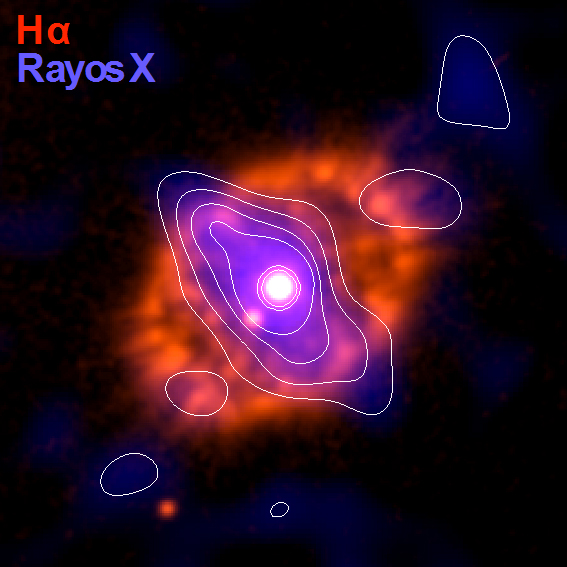Astronomers discover that novae, a type of explosions in double star systems, expand non-stop
The Institute of Astrophysics of Andalusia (IAA-CSIC) participates in the study of the expansion of the shell of material ejected by various nova explosions. They find that, contrary to what was assumed, novae expand unrestrained until their end, when they end up dissipating in the interstellar medium
Novae are explosive stellar phenomena that produce a shell of expanding material and, unlike supernovae, do not imply the disappearance of the parent star. Known for centuries, its evolution over time has been scarcely studied and the models predicted a reduction in their expansion rate in half after fifty to one hundred years. Now, a study reveals that the expansion of the nova is unstoppable until its end.
Novae occur in binary star systems in which one of the components is a white dwarf (the dense core of a solar-type star that has ejected its atmosphere). The white dwarf captures material from its companion star and forms a surface hydrogen layer that, upon reaching a certain critical mass, triggers an explosion -a nova- that increases its brightness by thousands of times and expels the outer layers at speeds of hundreds or thousands of kilometers per second. After a time, the system stabilizes and the process of accumulation of matter on the white dwarf resumes.
"This material forms a rapidly expanding shell that we can soon observe with space and ground telescopes", says Martín A. Guerrero, a researcher at the Institute of Astrophysics of Andalusia (IAA-CSIC) who participates in the work. “The complete evolution of a nova occurs on scales similar to those of human life, so that we can witness the entire process and make comparisons with similar, but much more extensive events in time, such as the formation of planetary nebulae or supernova explosions".
The evolution of novae is known to depend on the explosive event itself and on the interaction of the ejected material with the environment surrounding the stars, which may even have a common envelope. However, the evolution of the expansion of the material is hardly known. Until now we only had simplified models that pointed to a loss of speed of 50% of its initial value after a time interval of between fifty and one hundred years after the outbreak of the nova.
"The availability of high-quality long-term images of the nova shells in astronomical archives is a gold mine to assess their expansion", says Martín A. Guerrero (IAA-CSIC). Thus, the group of researchers used archival data, which was complemented by current images taken with the Nordic Optical Telescope, on the island of La Palma, to investigate the angular expansion of five nova shells aged between fifty and one hundred and thirty years.
And, contrary to theoretical expectations, the novae of the sample present an unrestrained expansion that will continue until its end, when they are diluted in the interstellar medium. "The mechanical energy and the momentum of the material in the shell of a nova is, apparently, large enough to sweep with no break the material around the white dwarf”, says Edgar Iván Santamaría, researcher at the University of Guadalajara (Mexico) who leads the work.
The best-studied case in this sample is DQ Her, a cataclysmic variable system (a pair of stars showing sudden and intense changes in brightness) that experienced an explosion in December 1934. DQ Her shows a very rapid expansion, a feature that led to the research team to study its hot gas content with the Chandra and XMM-Newton X-ray satellites.

“To our surprise, we observed that the material expelled in the nova presents a magnetized jet. This jet reveals that, after the 1934 explosion, the strong magnetic field of the system's white dwarf has taken control of the material being accreted onto its surface after the nova event”, says Jesús A. Toalá, researcher from the Institute of Radio Astronomy and Astrophysics (IRyA, Morelia, Mexico) that led the research on DQ Her.
E. Santamaría et al. "Angular expansion of nova shells". The Astrophysical Journal,892:60 (March 2020). https://iopscience.iop.org/article/10.3847/1538-4357/ab76c5/meta
J. A. Toalá et al. “Extended X-ray emission from the classic nova DQ Her – On the possible presence of a magnetized jet”. Monthly Notices of the Astronomical Society (June 2020) https://doi.org/10.1093/mnras/staa1502
Instituto de Astrofísica de Andalucía (IAA-CSIC)
Unidad de Divulgación y Comunicación
Silbia López de Lacalle - sll[arroba]iaa.es - 958230532
http://www.iaa.es
http://www-divulgacion.iaa.es

